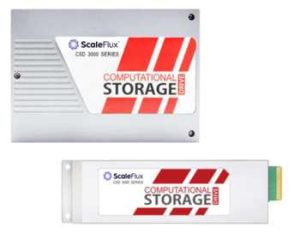Data Security and Performance: ScaleFlux on Overcoming Challenges Behind SDS
JB Baker, VP products, underscores complexities of SDS deployments.
This is a Press Release edited by StorageNewsletter.com on July 25, 2024 at 2:01 pmCost efficiency and scalability drive SDS adoption, with organizations leveraging automation and resource optimization to reduce expenses while increasing storage infrastructure.
(Image source: ScaleFlux)

JB Baker, VP, products, ScaleFlux, Inc., underscores the complexities of SDS deployments. Successfully addressing integration, security, performance optimization, and efficiency amid expanding data demands requires monitoring tools, load balancing, and scalable architecture.
Nearly 403 million terabytes of data are created daily, with an estimated creation of 147ZBs of data in 2024. (1)
In perspective, if 1km represented each terabyte of those 147ZBs, the result would be equivalent to 1,300 trips to the moon and back. (2) SDS frees organizations from proprietary hardware and provides maximum flexibility to meet escalating data storage needs, potentially achieving limitless scalability across networks of any size.
Baker cautions: “While SDS offers the potential for unparalleled scalability and flexibility, deployments need to be approached with eyes wide open to avoid security vulnerabilities, performance bottlenecks, and financial repercussions. By strategically addressing these areas, organizations can enhance their SDS deployments, making them more integrated with existing systems, secure, and capable of scaling efficiently without performance degradation.”
One of the primary challenges of SDS is integrating it with existing infrastructure. A comprehensive integration strategy is essential, beginning with a thorough assessment of current IT systems to identify compatibility issues. Customized integration solutions, including middleware and APIs, can bridge gaps between SDS and existing infrastructure. Collaborating with SDS vendors for support and expertise is also crucial.
“Starting with clear goals for your storage infrastructure can significantly streamline the integration process, whether you’re transitioning from traditional systems or starting from scratch,” Baker advises.
Organizations must adopt a robust security framework to prevent vulnerabilities from emerging as they deploy SDS environments. SDS offerings include security features. Users will need to carefully review and configure the settings to align with their corporate security structure. This includes data encryption at rest and/or in transit, rigorous access controls, and routine security audits. Regular updates and patch management are vital to ensure that all components of the SDS environment are protected. Advanced threat detection tools can quickly identify and mitigate risk, enhancing overall security.
“A multifaceted security approach is non-negotiable in SDS environments where data is distributed across various nodes and layers,” emphasizes Baker.
Performance bottlenecks in large-scale SDS mobilizations can be avoided through strategic scaling and resource management. Implementing performance monitoring tools and load balancing can dynamically allocate resources and prevent bottlenecks. Designing a scalable architecture and optimizing data placement and caching strategies are also vital. Selecting appropriate hardware and carefully configuring SDS settings, particularly for data reduction, can further enhance performance and efficiency.
Baker notes, “While being ‘hardware agnostic’ is a fundamental attribute of SDS, the selection of hardware – including the choice of drives – is crucial to meeting your performance and latency targets.“
Before transitioning to SDS, companies should carefully assess the financial implications. The transition can involve significant up-front costs as well as ongoing operational expenses. Phased implementation, leveraging existing infrastructure, and negotiating flexible pricing models with vendors can help manage initial expenditures. Regular cost-benefit analysis, optimizing resource utilization, and investing in automated management tools can balance overhead with long-term financial benefits. Evaluating the TCO and considering performance improvements and scalability are crucial for assessing SDS’s ROI. Once again, the choice of hardware configurations can have a significant effect on the overall TCO and reliability of the solution, with the right hardware reducing costs and improving reliability.
ScaleFlux helps users address these SDS challenges with advanced NVMe SSDs with built-in compute engines. These NVMe SSDs, designed for demanding 24×7 workloads, offer encryption, penalty-free data compression, and enhanced performance and endurance. Working closely with SDS vendors, the company integrates compression management directly into the SDS application, simplifying the user experience. The firm’s partners with VARs and systems integrators to offer pre-configured platforms tailored for SDS deployments, eliminating the guesswork in hardware selection.
The company’s commitment to continuous innovation ensures that its solutions evolve to meet the growing demands of the industry. By staying at the forefront of technological advancements and maintaining a focus on customer needs, the firm is a preferred partner for enterprises looking to optimize their storage infrastructure with a suite of solutions that enhance performance, security, and cost efficiency.
“ScaleFlux’s innovative technology and strategic partnerships make us a strong ally for organizations navigating the complexities of SDS,” Baker concludes. “Our solutions not only enhance performance and security but also reduce total cost of ownership, making SDS adoption more financially beneficial.”
(1) Duarte, Fabio. Amount of Data Created Daily (2024). Exploding Topics, Exploding Topics, June 13, 2024.
(2) Thomas Barnett, Jr. The Zettabyte Era Officially Begins (How Much Is That?). Cisco blogs, October 11, 2016.















 Subscribe to our free daily newsletter
Subscribe to our free daily newsletter

